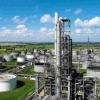|
|

Relief Piping Design Pressure
#1

Posted 17 February 2012 - 09:05 AM
I would like to ask you the following question:
What should be the design pressure for relief valve discharge pipe (outlet from valve)?
In API standards it can be found that discharge flange rating must resist the highest back pressure.
What should be then the design pressure of discharge pipe. Should it be larger than expected back-pressure?
I have estimated back-pressures for all my PSVs in the network (different cases) and now arguing with people from mechanical/piping department trying to convince me that normal operating pressure for such discharge piping is close to atmospheric. In other words I was told that my back-pressures can occure very rarely and the piping "should" resist that back-pressures.
The question is "should it?". Is it OK from formal point of view if they take for strenght calculations lower pressure than max back-pressure, assuming that normal operation of such piping is when the PSV is closed.
To be more clear: we know that our pipe can resist even higher pressures than my max. back-pressure but the question is what to specify as a normal operating and then design pressure for such pipe? What to say to people from so called "NOTIFIED BODY" (eg. TUV). Should such pipe be a part of NOTIFIED BODY supervision?
I have a feeling that the answer is easy and obvious for all experienced people here.
#3

Posted 18 February 2012 - 12:47 PM
The design pressure of the PSV tailpipe should be greater than or equal to the highest back pressure which you calculate, taking into account the pressure in the main header at the given relief case and a margin for uncertainty in the calculation (increased pipe length etc).
The design pressure ensures that the piping is hydrotested to a suitable pressure ( usually 1.5 x Design), so that we can be confident that there will be no leaks when the PSV goes off.
The design pressure is determined by the process engineer, end of story. The opinions of Piping or Mechanical do not come into it. They usually like it that way, it frees them of responsibility and allows them to blame Process for delays, changes etc.
I don't know what you mean by a Notified Body or TUV. The flare system piping design is subject to the same design codes and requirements as all other process piping.
Paul
#4

Posted 22 February 2012 - 03:37 AM
Dear Friends,
I would like to ask you the following question:
What should be the design pressure for relief valve discharge pipe (outlet from valve)?
In API standards it can be found that discharge flange rating must resist the highest back pressure.
What should be then the design pressure of discharge pipe. Should it be larger than expected back-pressure?
I have estimated back-pressures for all my PSVs in the network (different cases) and now arguing with people from mechanical/piping department trying to convince me that normal operating pressure for such discharge piping is close to atmospheric. In other words I was told that my back-pressures can occure very rarely and the piping "should" resist that back-pressures.
The question is "should it?". Is it OK from formal point of view if they take for strenght calculations lower pressure than max back-pressure, assuming that normal operation of such piping is when the PSV is closed.
To be more clear: we know that our pipe can resist even higher pressures than my max. back-pressure but the question is what to specify as a normal operating and then design pressure for such pipe? What to say to people from so called "NOTIFIED BODY" (eg. TUV). Should such pipe be a part of NOTIFIED BODY supervision?
I have a feeling that the answer is easy and obvious for all experienced people here.
if you have 3 psvs
1- relieving at 10 psig
2- at 50
3- at 250 psig
and relief header gets gets max back pressure when number 3 goes off then you need to design tail pipe of number 1 and to upto the mark to resist that high pressure. this clause comes into play like that.
.
.
.
Also the hydrotest pressure being 1.5 x of design pressure is concerned dont rely on that, that is just to accomodate the actual relief conditions like high temperature, since hydrotest wont be done on that exact operating conditions
Edited by Exclamation, 22 February 2012 - 03:37 AM.
#5

Posted 22 February 2012 - 04:04 AM
Similar Topics
Steam Pressure In Heat ExchangerStarted by Guest_mvanrijnbach_* , 15 Apr 2025 |
|

|
||
Scrubber DesignStarted by Guest_nasss_* , 07 Aug 2024 |
|

|
||
Critical Pressure For Choke Valve SizingStarted by Guest_Sherif Morsi_* , 07 Nov 2017 |
|

|
||
Refinery Lpg Deethanizer Column DesignStarted by Guest_Ilyes_* , 15 Feb 2025 |
|

|
||
Alkaline Electrolytic Cell/stack Sizing/design For H2 ProductionStarted by Guest_BRS09_* , 13 Mar 2025 |
|

|

 FB
FB








